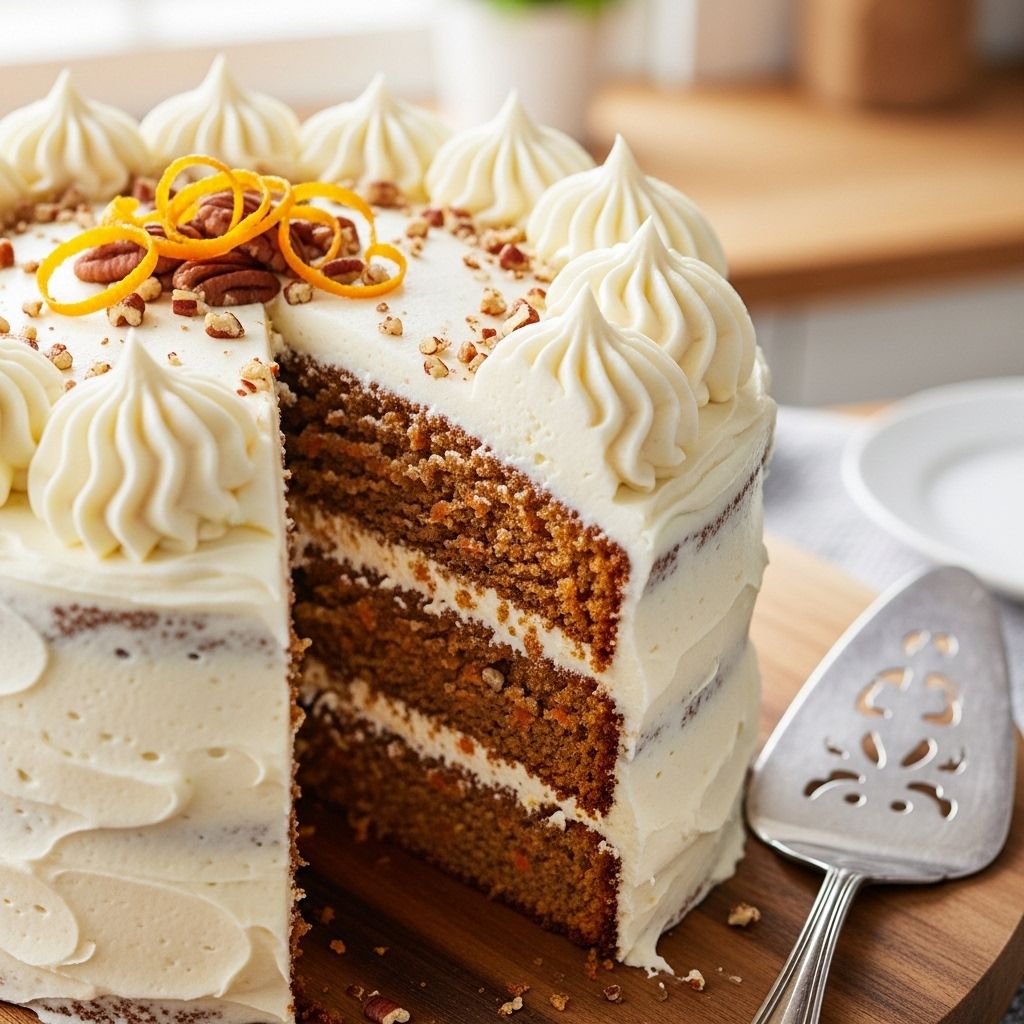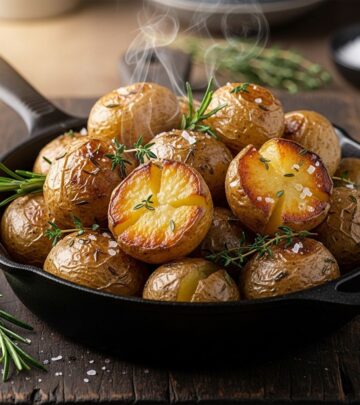Classic Cream Cheese Frosting: A Versatile, Tangy-Sweet Favorite
Transform simple cakes and cookies into delicious delights with a smooth topping.

Cream cheese frosting stands as one of the most beloved and versatile toppings in the world of desserts. Whether slathered on a decadent carrot cake, dolloped over spiced cupcakes, or sandwiched between cookies, its unmistakable tang and fluffy texture make it an unbeatable choice for home bakers and professionals alike. In this article, you’ll discover not just how to whip up the perfect batch of cream cheese frosting, but also practical tips, variations, and creative ways to use it across a range of desserts.
Why Cream Cheese Frosting Deserves a Spot in Every Baker’s Arsenal
There’s a reason cream cheese frosting is a fixture in classic and contemporary baking. Its rich and creamy profile balances sweetness with a distinctive tang, enhancing rather than overpowering the flavors of cakes, bars, and cookies. In addition:
- Universally loved: Its signature flavor and smooth texture appeal to nearly everyone, from casual treat seekers to devoted dessert fans.
- Complementary: Cream cheese frosting pairs especially well with spiced, fruity, or nutty baked goods, as well as chocolate and citrus-based recipes.
- Simple to prepare: With just a few staple ingredients and minimal equipment, anyone can master the technique in a matter of minutes.
- Customizable: It accepts add-ins, colorings, and flavorings, adapting to decorations and seasonal twists effortlessly.
Ingredients for Classic Cream Cheese Frosting
To create a superior batch of cream cheese frosting, use quality ingredients at the right temperatures. Here’s what you’ll need:
| Ingredient | Amount | Notes |
|---|---|---|
| Cream Cheese | 12 oz. | Full-fat, block-style, at room temperature. Avoid whipped or spreadable types for best texture. |
| Salted Butter | 12 Tbsp. (1½ sticks) | At room temperature. Salted butter adds subtle depth; unsalted also works but consider adding a pinch of salt. |
| Powdered Sugar | 7 cups | Also known as confectioners’ sugar, sifted to remove lumps. |
| Vanilla Extract | 2 tsp. | Pure vanilla brings warmth and complexity. |
Tip: Substituting low-fat, whipped, or tub-style cream cheese will result in a runnier, less stable frosting.
Step-by-Step Directions: Making Cream Cheese Frosting
- Cream Together Butter and Cream Cheese
In a stand mixer fitted with a paddle attachment—or using a large bowl and an electric hand mixer—beat the butter and cream cheese on medium-high speed until smooth and lump-free, about 2 to 3 minutes. - Add Sweetness and Flavor
Turn the mixer to low and gradually add the powdered sugar and vanilla extract. Once combined, increase the speed to medium and beat until fluffy, 2 to 3 minutes. - Test Texture and Taste
Scrape down the sides with a spatula to ensure even mixing. Taste and, if desired, add a pinch of salt to balance sweetness. - Ready to Use
If spreading right away, the frosting is ready. For piping, chill slightly to help it hold shape.
Visual Guide: Getting the Right Consistency
- Smooth and creamy for swirling on cakes or cupcakes.
- Stiffer and pipeable if you plan to decorate or use with intricate designs—chill briefly or add a little more powdered sugar as needed.
- If runny: Chill in the fridge for 20 minutes, or incrementally beat in extra powdered sugar.
Pro Tips for Perfect Cream Cheese Frosting
- Room Temperature Ingredients: Ensure both the butter and cream cheese have softened to room temperature before you begin to avoid lumps and achieve a perfectly smooth texture.
- Sift the Sugar: Powdered sugar can clump in storage, so always sift before adding to avoid grainy frosting.
- Gradual Mixing: Add the powdered sugar in increments, mixing after each addition—this prevents a sugar cloud and also assures a silky consistency.
- Avoid Overbeating: Once fluffy and spreadable, stop the mixer. Overbeating can cause the frosting to become too slack or runny due to the cream cheese softening further.
- Flavor Variations: Enhance with lemon zest, cocoa powder for chocolatey flavor, cinnamon, or almond extract to suit your dessert.
How to Store and Make Ahead
- Refrigeration: Store cream cheese frosting in an airtight container in the refrigerator for up to 3 days. Bring to room temperature and briefly re-whip for best spreading texture before using.
- Freezing: For longer storage, freeze for up to 1 month. Thaw overnight in the fridge, then mix again until fluffy.
Expert Answers: Frequently Asked Questions
Q: Can you pipe cream cheese frosting onto cupcakes or cakes?
A: Yes, provided you achieve a thick-enough consistency. If too soft, chill for 15–30 minutes or beat in additional powdered sugar to stiffen before piping.
Q: What’s the best way to prevent runny cream cheese frosting?
A: Always use full-fat, block-style cream cheese and real butter, not margarine. Avoid overbeating, especially once the sugar is added. If the frosting is too loose, chilling it helps set it up.
Q: Can this frosting be colored or flavored?
A: Absolutely! Add gel food coloring or flavor boost add-ins (like citrus zest or spices). For chocolate cream cheese frosting, beat in 1/2 cup sifted cocoa powder after creaming the butter and cream cheese.
Q: What cakes and desserts pair best with cream cheese frosting?
A: Carrot cake, red velvet cake, pumpkin bars, spice cupcakes, banana bread, cinnamon rolls, and cookies are all classics that shine with a cream cheese topping. Its tang also elevates chocolate, lemon, or apple desserts.
Q: Can I reduce the sugar in the frosting?
A: You can try—but less sugar means a looser, softer frosting. To balance, chill well before spreading and consider using slightly less butter or cream cheese to keep it stable.
Creative Uses and Serving Suggestions
- Classic Carrot Cake: Spread generously atop your favorite carrot or hummingbird cake, finishing with chopped pecans for extra crunch.
- Pumpkin Bars and Cupcakes: Frost warm pumpkin desserts for an autumnal treat.
- Cookies and Cookie Sandwiches: Use as a filling between spiced or oatmeal cookies, or pipe onto sugar cookies as a sweet finish.
- Cinnamon Rolls: Slather thickly on freshly baked cinnamon rolls straight from the oven.
- Breakfast Pastries: A light spread on scones, banana bread, or muffins transforms breakfast into something special.
Flavor Variations and Customizations
- Chocolate Cream Cheese Frosting: Beat in 1/2 cup sifted cocoa powder for a chocolatey twist.
- Citrus Zest Add-In: Lemon, orange, or lime zest can brighten the flavor and pair beautifully with fruit-based cakes.
- Spiced Version: Mix in cinnamon, nutmeg, or pumpkin pie spice for warmth during cooler months.
- Nutty Crunch: Fold in chopped toasted pecans or walnuts for texture.
How to Get the Perfect Finish: Expert Techniques for Decorating
- Spread or Swirl: Use an offset spatula for luxurious swirls on cakes. For a classic swoopy look, pile the frosting high and rotate the cake as you go.
- Piping Tips: For piping, chill the frosting briefly, fit a pastry bag with a star tip, and pipe florets or borders.
- Smooth Layer: For an ultra-smooth finish (great for layer cakes), apply a crumb coat first (a thin layer to seal crumbs), chill, then finish with a final thick layer of frosting.
Storage, Make-Ahead, and Freezing Quick Guide
| Storage Method | How Long? | Notes |
|---|---|---|
| Room Temperature | Not recommended | Contains cream cheese; may spoil if unrefrigerated. |
| Refrigerator | Up to 3 days | Bring to room temperature and re-whip before using. |
| Freezer | Up to 1 month | Thaw overnight and beat again to restore fluffiness. |
Quick Reference: Troubleshooting Your Frosting
- Lumpy Texture: Start with room-temperature cream cheese and butter, and sift your powdered sugar.
- Too Sweet: Add a pinch of salt or a touch more cream cheese to mellow the sweetness.
- Too Loose: Add more powdered sugar gradually, or refrigerate to firm up.
- Too Firm: Let sit out for a few more minutes before spreading, or add a teaspoon or two of milk for a softer consistency.
More Recipes and Inspiration
Now that you’ve mastered classic cream cheese frosting, try using it on these treats:
- Pumpkin Coffee Cake
- Red Velvet Cupcakes
- Classic Carrot Cake
- Layered Pumpkin Bars
- Chocolate Sheet Cakes
- Banana Bread Muffins
Summary: Why Homemade Cream Cheese Frosting Is Unbeatable
Homemade cream cheese frosting is superior to store-bought in flavor, texture, and versatility. By following these simple instructions, you’ll gain a foolproof, adaptable recipe that crowns any dessert with elegance and tangy sweetness. Experiment with variations and enjoy the compliments that will surely follow when you serve your stunning, home-baked creations crowned with this luscious frosting.
Frequently Asked Questions (FAQs)
Q: How long can I leave cream cheese frosting out at room temperature?
A: Cream cheese frosting is perishable and should not sit out for more than two hours. Always store any frosted items in the refrigerator for safety.
Q: Can I double or halve this recipe?
A: Yes, simply double or halve all ingredients as needed. Ensure your mixing bowl is large enough when doubling, and monitor mixing times.
Q: Can I use this frosting for layer cakes?
A: Absolutely. This frosting fills and covers a standard 9-inch layer cake or a large sheet cake beautifully.
Q: What should I avoid when making cream cheese frosting?
A: Avoid using low-fat or whipped cream cheese, and don’t overbeat once the sugar is fully incorporated, as this can make the frosting too soft.
Q: Is this frosting gluten-free?
A: Yes. Provided you use gluten-free vanilla extract and powdered sugar, this frosting is naturally gluten-free.
References
- https://www.loveandlemons.com/cream-cheese-frosting/
- https://www.thepioneerwoman.com/food-cooking/recipes/a66031083/cream-cheese-frosting-recipe/
- https://www.thepioneerwoman.com/food-cooking/recipes/a11885/pumpkin-sheet-cake/
- https://www.thepioneerwoman.com/food-cooking/recipes/a11735/sigrids-carrot-cake-perfect-for-easter/
- https://www.thepioneerwoman.com/food-cooking/recipes/a64177336/carrot-cake-cupcakes-recipe/
- https://www.youtube.com/watch?v=UTIS1sMatek
- https://www.thepioneerwoman.com/food-cooking/recipes/a8888/moist-pumpkin-spice-muffins-with-cream-cheese-frosting/
Read full bio of medha deb












